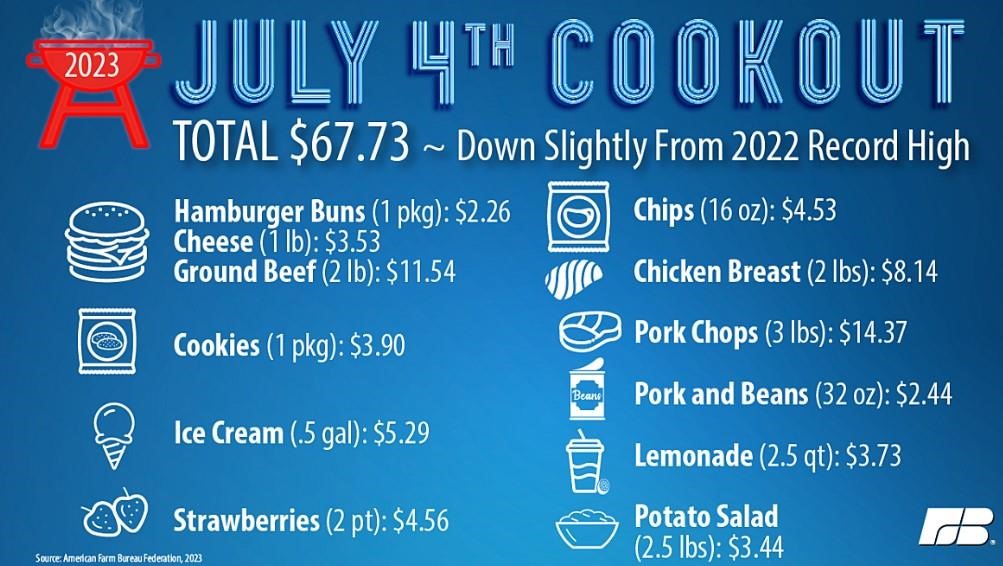Future cattle prices could hinge on weather and subsequent grazing availability and/or input costs, such as grain., said David Anderson, Ph.D., AgriLife Extension livestock marketing economist, Bryan-College Station. Retail beef prices could be influenced by beef imports and the largest amount of beef in cold storage since 2016.

However, future cattle and beef prices hinge on long-term size of the U.S. herd, Anderson said.
Calf prices remain strong, and the market experienced recent increases, but Anderson expects herds to continue to shrink in 2023. He expects calf and beef prices to climb, but it could be 2024 before the market pushes them toward new records.
“We’re getting there in terms of fewer animals and calves, but demand for cattle and beef hasn’t been subject to a supply-demand imbalance that could really impact prices,” he said.
Calf prices stay strong, consumer demand steady
So far, there has been no real change in beef demand, Anderson said. A record amount of beef – 28.3 billion pounds – was produced in 2022 on the heels of deeper than usual herd culling by Texas ranchers, according to the U.S. Department of Agriculture. The agency also reported 544 million pounds of beef in cold storage, which is the second highest since tracking began in 1973.
Demand for hamburgers and steaks remains steady despite inflation and interest rate hikes by the Federal Reserve, which have slowed the economy. But Anderson said he wonders at what point might consumer demand for beef decline as shoppers look for cheaper options and how any decline might impact cattle prices.
Calf prices in the Southern Plains market were $2.31 per pound compared to $2 the same time last year and the five-year average of $1.69 per pound for 500–600-pound calves. They were even higher – $2.42 per pound – at the 400–500-pound weight class compared to $2.16 per pound last year and the five-year average of $1.87 per pound.
Feedlots are buying steers amid strong cutout value, Anderson said. Cutout relates to the value average across seven major primal cuts, including chuck, loins, ribs and briskets, at wholesale.
Cutout values were relatively flat – $2.76 per pound – compared to $2.70 per pound in 2022, but 30% higher than the five-year average of $2.12 per pound. Anderson said retail beef prices were down slightly compared to last year.
“People are still buying beef, and that’s a good thing,” he said. “We had a lot of beef out there this past year, and the runups in calf prices at that point were related to higher production costs in relation to calf prices.”
Market imbalance likely leads to higher calf and beef prices
The high cost of grains and other supplemental feed coupled with poor grazing and forage production led many producers to cull before costs surpassed the profit potential of strong prices.
Despite widespread rain over recent weeks, many parts of the state continue to experience extremely dry conditions, according to the U.S. Drought Monitor. Around 77% of Texas is dealing with some degree of drought, and 31% of the state is in severe to exceptional drought.
Producers in many areas continue to reduce cattle numbers or liquidate herds according to AgriLife Extension agent reports. But agents in other parts of the state are reporting vastly improved soil moisture conditions.
There is an expectation that grazing on native grasses or improved cool-season grasses like winter wheat and ryegrass could boom with sunny days and warmer temperatures.
“It will take everyone deciding the drought is over before the Texas herd begins expanding again,” he said. “Some producers with good moisture and grazing may take on more calves to take advantage of the opportunity for good low-cost gains. That could drive calf prices up some more, but I still don’t think that causes an imbalance.”
The market “imbalance” scenario is likely to play out like the last statewide drought in 2011, Anderson said. Prolonged drought and an arid summer with poor grazing, hay production and limited water resources led Texas cattle ranchers to cut the state herd from almost 5 million to 3.9 million by 2014.
Anderson said prices were strong after 2012 but by 2015, calf prices were setting all-time records as ranchers moved to rebuild their herds and take advantage of strong consumer demand and reduced supply, thus driving beef prices upward.
“I don’t expect price escalation to happen until we rebuild the herd,” he said. “That means producers are holding back more heifers to replace cows, and so there will be fewer head ending up in grocery stores. That process really constricted the beef and cattle markets and drove prices up.”
AgriLife Extension district reporters compiled the following summaries:

A map of the 12 Texas A&M AgriLife Extension districts.
CENTRAL
Soil moisture was very short to adequate. Pastures were starting to green up with warmer temperatures, but growth was mostly weeds. Soil temperatures began to rise, but Bermuda grass remained dormant. Producers were top dressing oat and wheat fields and planting corn. Fruit trees were beginning to bud. Runoff from recent rains improved stock tanks, but water levels were still very low. Calving season began. Rangeland and pasture conditions were very poor to good. Supplemental feeding was still necessary for livestock.
ROLLING PLAINS
Temperatures were warmer before a cold front at the end of the week. Light rain was reported in some areas. Rain amounts ranged from a trace up to 2 inches. Soil moisture was improving in parts of the district, but many areas remained very short to short. Wildfire danger remained a concern in many areas. Winter wheat was starting to grow, and most fertilized fields with adequate moisture looked good to excellent and should be grazed soon. Some wheat fields were in poor condition or showing moisture stress. Producers were top-dressing wheat fields. Some other fieldwork occurred where there was adequate moisture. Rangeland and pasture conditions were poor. Ranchers continued to feed cattle hay and supplements. Some water tanks caught runoff water. Most herds had been culled deeper than usual. Producers applied preemergent herbicides to pastures. Soil erosion due to drought and high winds was reported.
COASTAL BEND
Most of the area reported warmer temperatures and plenty of sunshine. Topsoil moisture throughout the district decreased significantly due to warmer, windy weather. Subsoil moisture levels were short in some areas but remained too wet to plant in other areas. Corn and grain sorghum were planted as moisture allowed. Most pastures continued to see new growth of grasses and clover as temperatures and sunny days increased. As a result, hay consumption slowed. Livestock producers continued supplementing protein and limited hay. Some spring calves were born, and livestock remained in good condition. Cattle prices were steady to above average for this time of year.
EAST
Many areas were still saturated from recent rainfall. Warmer temperatures and wind helped dry out some areas. Pasture and rangeland conditions were fair. Subsoil and topsoil conditions were adequate. Timber production slowed down due to wet conditions on some tracts. Livestock were in fair to good condition with supplementation taking place. Some cattle and other livestock were finding green grass and backing off hay a little. Hay supplies continued to be short throughout the district. Wild pig activity increased with lots of destruction in pastures and cropland reported.
SOUTH PLAINS
High winds dried out fields. Winter wheat needed moisture to make a crop. Alfalfa was beginning to green up. Many pastures were overgrazed this winter. Cattle producers were feeding hay and supplements.
PANHANDLE
Dry conditions continued across the district, though some areas received light rains. High winds dried the moisture quickly. Soil moisture levels were very short to short. Wind gusts between 75-114 mph were reported. Damage included downed power lines, trees and several roofs destroyed. Constant wind made it extremely hard to plant wheat. Most farmers were having to replant fields that were blown out, but expectations were low due to low moisture. Pastures and rangeland were in poor condition, and producers continued to feed hay and supplements. Producers may start moving herds soon due to short hay supplies and little to no wheat for grazing.
NORTH
Soil moisture was short to adequate in most of the counties. Most areas received rain over the past few weeks. Temperatures were up and down. Wheat and oats were improving with the recent moisture and should make more progress in the coming weeks if temperatures stay warm. Producers were fertilizing pastures. Livestock were grazing cool-season grasses. Fruit trees were budding out. Hay was still in high demand. Livestock conditions were good overall.
FAR WEST
Extremely windy conditions persisted, bringing a high risk of wildfire. Gusts of 40-80 mph were reported. Temperatures were in the mid-60s to mid-70s during the day and mid-30s to mid-40s overnight. A small rain shower delivered trace amounts of precipitation. The rain was the first moisture in a month and brought the 2023 total to 0.33 of an inch. The wheat crop declined very rapidly, and only irrigated fields were expected to be harvested. Remaining wheat was approaching bunt stage and will be heading out in the next few weeks. Most field work was slowing down. Preplant irrigation increased for many growers. Producers may decrease acres so they can provide more water to planted crops. Some growers said they will not irrigate unless substantial moisture arrives soon. Corn and sorghum planting was scheduled to begin in the next few weeks. Pasture and rangeland conditions were dry and hard. Cattle numbers were extremely low and remained in poor to fair condition. Producers continued their supplemental feeding regimens. Sheep were lambing, and kidding should follow soon.
WEST CENTRAL
Temperatures were mild to warm. All areas needed rain, and a quick moving storm delivered trace amounts to a few areas. Wheat and oat fields needed significant moisture. Plants, including fruit trees, were breaking dormancy due to temperatures in the high-70s and low-80s. Rangeland and pasture conditions improved slightly with some cool-season grasses being grazed by livestock and wildlife. Livestock diets continued to be supplemented, but hay supplies were getting low. Some livestock producers continued to sell cattle to reduce herd sizes.
SOUTHWEST
Weather was warm, dry and windy with no rain reported. Lack of moisture was limiting winter weed and grass growth. Corn and sorghum plantings were underway. Irrigated winter wheat and oats were in fair to good shape. Rangelands continued to be dry as lambing and kidding continued. Spring shearing was underway. Livestock were receiving supplemental feed and in mostly fair condition.
SOUTH
Soil moisture levels were very short to short. Windy conditions were reported in some areas. Temperatures were above normal. Strawberries were starting to flower and put on fruit. Other fruit crops were also budding out and flowering. Some producers were preparing crop fields, and planting was underway in parts of the district. Most corn planting was complete in southern parts of the district, and sorghum planting was in full swing. Some early planted corn and sorghum established good stands. Citrus, sugarcane and winter vegetable harvests continued. Rangeland and pasture conditions were poor to good, but most areas were declining. Crops were being irrigated. Supplemental feeding continued or increased to maintain good body condition scores in all livestock. Prices for feed, hay and supplements were still high and increasing. Cattle prices were steady. Mesquite trees were leafing out.
Source : tamu.edu